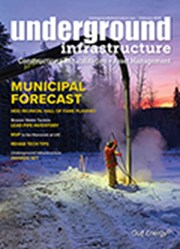June 2012, Vol. 67 No. 6
Features
Research Needs, Options Before Purchasing A Mud Recycler

If you have come to the realization that you need a mud recycler, now what? Where do you start? What do you need to know to make the best informed decision?
With so many manufacturers, sizes, makes, models and options, it’s like trying to choose a car. First and foremost, you need to decide what size recycler would be most beneficial to your business. Units generally range from 80 to 2,000 gallons per minutes (gpm).
The simplest way to determine the size is to base it on 1½ to two times the amount you are pumping. In other words, if you are pumping 200 gpm, you will need a recycler that would be able to pump at least 300-400 gpm.
Once you have determined the size, there are several other aspects that you will want to consider.
Shakers – There are three types of shakers on a recycler: orbital, elliptical and linear. While each type has its place, the preferred is the linear shaker.
Screen surface – Screen surface is one place where “bigger is better.” The larger the screen surface, the more volume you can clean.
Screens – Screen sizes can range from 10 to 350 or more. The mesh size is calculated by the number of openings in a square inch. The larger the mesh size, the finer the screen. You never know what type of conditions you may be drilling in so it is best to be offered a wide variety of mesh sizes.
Cones – Cone size will vary depending on the size of the unit you choose. You will either have four- or five-inch cones on the smaller units which will operate at 30 to 40 psi, or 10- to 12-inch cones on the larger units which operate on 23 to 35 psi.
Trailer or skid mounted – Mud systems can be trailer mounted or skid mounted. Skid-mounted units can be easily removed and will, in turn, free-up your trailer. But you will also need to have a way of loading and unloading the unit on the jobsite.
Manufacturer support
Once you have decided on the best size recycler for your business, the search for a manufacturer begins. Just like purchasing a car, do your research. Does the manufacture offer additional options? Can you add or change features, have the unit painted with your company colors, make it explosion proof?
There are many different types of drilling businesses and each has their own requirements and needs. With that in mind, you may want a recycler that is more customized to suit your drilling needs. If you are going to invest in a recycler, why not have your recycler built to suite your needs?
If this your first experience with a recycler, your crew will need some help and training. The Owner’s Manual is a great source of information but there will be times when experienced technical support could make the difference in being operational and being “down.” Check to see what type of training and support the manufacturer offers.
What about parts? Does the manufacturer carry the necessary parts that you will need for your job, regular maintenance or repairs or will you have to find them on your own? It is better to know beforehand rather than when you are in a remote area drilling.
What type of warranty does the manufacturer offer? Just like any other big purchase, you want to protect your investment and be assured that the manufacturer stands behind what they sell.
Once you have completed your research, if you are still not sure, rent. Renting is the best way to find out if a recycler is what you need and want. Not to mention it will also give you a better insight into what you want in a recycler.
Remember, you want it to suite your needs.
About the author: Jan Wadsworth is with Mud Technology International, www.mud-tech.com, (866) 675-3240.




Comments